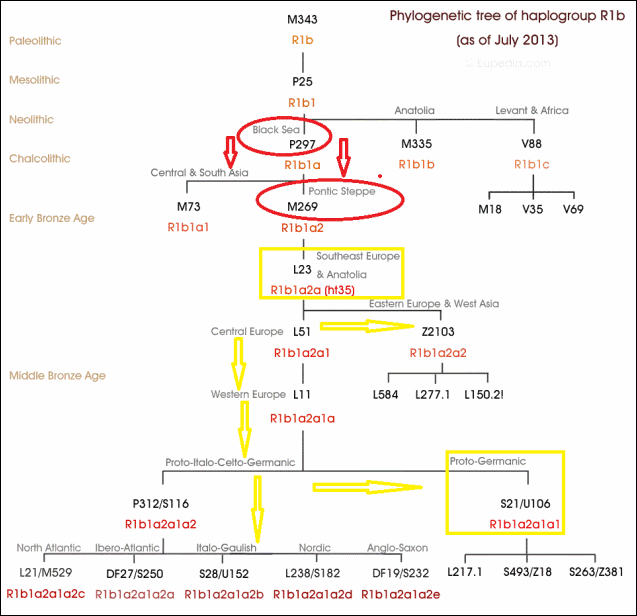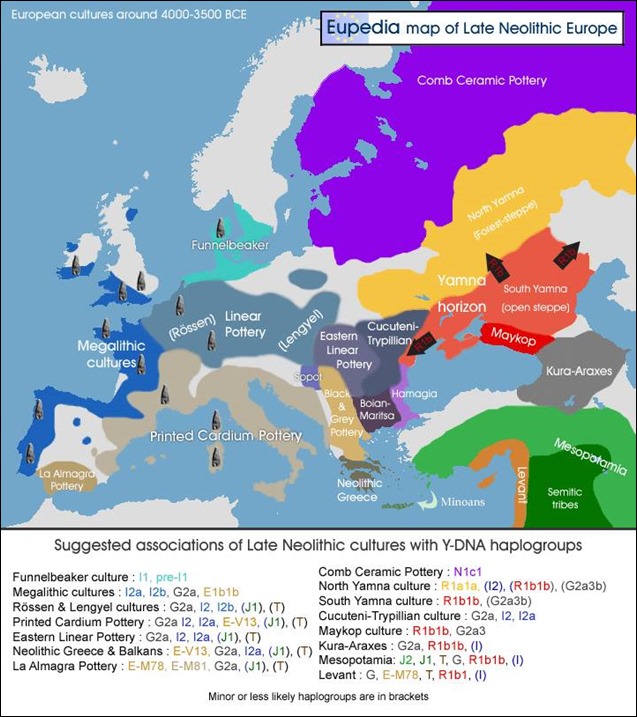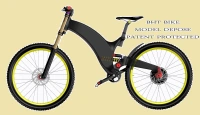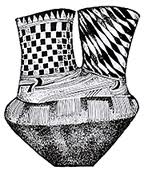In the archaeology of Neolithic Europe, the burned house horizon is the geographical  extent of the phenomenon of intentionally burned settlements. This was a widespread and long-lasting tradition in what is now Southeastern and Eastern Europe, lasting from as early as 6,500 BCE (the beginning of the Neolithic) to as late as 2000 BCE (the end of the Chalcolithic and the beginning of the Bronze Age). A notable representative of this tradition is the Cucuteni-Trypillian culture, which was centered on the burned-house horizon both geographically and temporally.
extent of the phenomenon of intentionally burned settlements. This was a widespread and long-lasting tradition in what is now Southeastern and Eastern Europe, lasting from as early as 6,500 BCE (the beginning of the Neolithic) to as late as 2000 BCE (the end of the Chalcolithic and the beginning of the Bronze Age). A notable representative of this tradition is the Cucuteni-Trypillian culture, which was centered on the burned-house horizon both geographically and temporally.
The roots of Cucuteni-Trypillian culture can be found in the Starčevo-Körös-Criș and Vinča cultures of the 6th to 5th millennia,[6] with additional influence from the Bug-Dniester culture (6500-5000 BC).[20] During the early period of its existence (in the 5th millennium BC), the Cucuteni-Trypillian culture was also influenced by the Linear Pottery culture from the north, and by the Boian-Giulesti culture from the south.[6] Through colonization and acculturation from these other cultures, the formative Pre-Cucuteni/Trypillia A culture was established. Over the course of the fifth millennium, the Cucuteni-Trypillian culture expanded from its ‘homeland’ in the Prut–Siret region along the eastern foothills of the Carpathian Mountains into the basins and plains of the Dnieper and Southern Bug rivers of central Ukraine.
<<1]Prut-Siret homeland > 2]4800-4000bc extend over Dniester-Bug basins > 3]4000-3500bc extend to Eastern Transylvania and to the Dnieper basin >
4]3500-3000bc extend to N Ukraine/Kiev and E to Don&Volga + transformation into a patriarchal structure + different forms of ritual burial were developed>> Thus the last phase of the Cucuteni culture is already a mixture, the transformation into a patriarchal structure and the different forms of burial show the mixture between the farmers and the kurgan people. Over 1000years the farmers and the kurgan people traded, mixed, the last 500 year period there is a mixed population with a culture still dominated by the older ways, so there was not a violent and sudden end for the Cucuteni culture, there was a transformation that lasted many hundreds of years.
mixture, the transformation into a patriarchal structure and the different forms of burial show the mixture between the farmers and the kurgan people. Over 1000years the farmers and the kurgan people traded, mixed, the last 500 year period there is a mixed population with a culture still dominated by the older ways, so there was not a violent and sudden end for the Cucuteni culture, there was a transformation that lasted many hundreds of years.
There was also a climate change – Beginning around 3200 BC the earth’s climate became colder and drier than it had ever been since the end of the last Ice age, resulting in the worst drought in the history of Europe since the beginning of agriculture.[27] The Cucuteni-Trypillian culture relied primarily on farming, which would have collapsed under these climatic conditions in a scenario similar to the Dust Bowl of the American Midwest in the 1930s.
The Contact Area is where I2/Cucuteni people met first with R1a than with R1b. I quote from the Eupedia page reffering to R1b, to the origin of ”indo-europeans”:
”It is not yet entirely clear when R1b crossed over from eastern Anatolia to the Pontic-Caspian steppe. This might have happened with the appearance of the Dnieper-Donets culture / c. 5100-4300 BCE, the first truly Neolithic society in the Pontic-Caspian Steppe. However, many elements indicate a continuity in the Dnieper-Donets culture with the previous Mesolithic hunter-gatherers, and at the same time an influence from the Balkans and Carpathians, with regular imports of pottery and copper objects. It is therefore more likely that Dnieper-Donets marked the transition of indigenous R1a and/or I2a1b people to early agriculture, perhaps with an influx of Near Eastern farmers from ‘Old Europe’. Mitochondrial DNA sequences from Dnieper-Donets culture showed clear similarities with those of the Cucuteni-Trypillian culture in the Carpathians (haplogroups H, T and U3).
The first clearly Proto-Indo-European culture was Sredny Stog / 4600-3900 BCE <also in the Dnieper-Don area, just next to the Cucuteni area>… There is evidence of population blending from the variety of skull shapes. Towards the end of the 5th millennium, an elite starts to develop with cattle, horses and copper used as status symbols.

The Maykop culture, the R1b link to the steppe – archeology also shows a clear diffusion of bronze working and kurgan-type burials from the Maykop culture to the Pontic Steppe, where the Yamma culture developed soon afterwards (from 3500 BCE)… R1b-M269 (the most common form in Europe) is closely associated with the diffusion of Indo-European languages, as attested by its presence in all regions of the world where Indo-European languages were spoken in ancient times, from the Atlantic coast of Europe to the Indian subcontinent. It has been hypothetised that R1b people (perhaps alongside neighbouring J2 tribes) were the first to domesticate cattle in northern Mesopotamia  some 10,500 years ago. The analysis of bovine DNA has revealed that all the taurine cattle (Bos taurus) alive today descend from a population of only 80 aurochs. The earliest evidence of cattle domestication dates from circa 8,500 BCE in the Pre-Pottery Neolithic cultures in the Taurus Mountains. The two oldest archaeological sites showing signs of cattle domestication are the villages of Çayönü Tepesi in southeastern Turkey and Dja’de el-Mughara in northern Iraq, two sites only 250 km away from each others. This is presumably the area from which R1b lineages started expanding – or in other words the “original homeland” of R1b. Horses were first domesticated around 4600 BCE in the Caspian Steppe, perhaps somewhere around the Don or the lower Volga, and soon became a defining element of steppe culture. Nevertheless it is unlikely that R1b was already present in the eastern steppes at the time, so the domestication of the horse should be attributed to the indigenous R1a people.
some 10,500 years ago. The analysis of bovine DNA has revealed that all the taurine cattle (Bos taurus) alive today descend from a population of only 80 aurochs. The earliest evidence of cattle domestication dates from circa 8,500 BCE in the Pre-Pottery Neolithic cultures in the Taurus Mountains. The two oldest archaeological sites showing signs of cattle domestication are the villages of Çayönü Tepesi in southeastern Turkey and Dja’de el-Mughara in northern Iraq, two sites only 250 km away from each others. This is presumably the area from which R1b lineages started expanding – or in other words the “original homeland” of R1b. Horses were first domesticated around 4600 BCE in the Caspian Steppe, perhaps somewhere around the Don or the lower Volga, and soon became a defining element of steppe culture. Nevertheless it is unlikely that R1b was already present in the eastern steppes at the time, so the domestication of the horse should be attributed to the indigenous R1a people.
The Yamna period / 3500-2500 BCE is the most important one in the creation of Indo-European culture and society. Middle Eastern R1b people had been living and blending to some extent with the local R1a foragers and herders <and with I2 farmers/salt&pottery traders from Cucuteni> for over a millennium, perhaps even two or three. The close cultural contact and interactions between ,<I2>, R1a and R1b people all over the Pontic-Caspian Steppe, resulted in the creation of a common vernacular, a new lingua franca, which linguists have called Proto-Indo-European (PIE). It is pointless to try to assign another region of origin to the PIE language.” end of quote, I have inserted the <I2> parts.
The Yamna horizon was not a single, unified culture. In the south, along the northern shores of the Black Sea coast until the the north-west Caucasus, was a region of open steppe, expanding eastward until the Caspian Sea, Siberia and Mongolia (the Eurasian Steppe). The western section, between the Don and Dniester Rivers (and later the Danube), was the one most densely settled by R1b people, with only a minority of R1a people (5-10%). The eastern section, in the Volga basin until the Ural mountains, was inhabited by R1a people with a substantial minority of R1b people (whose descendants can be found among the Bashkirs, Turkmans, Uyghurs and Hazaras, among others). The northern part of the Yamna horizon was forest-steppe occupied by R1a people, also joined by a small minority of R1b (judging from modern Russians and Belarussians, the frequency of R1b was from seven to nine times less lower than R1a). The western branch would migrate to the Balkans and Greece, then to central and Western Europe, and back to their ancestral Anatolia in successive waves (Hittites, Phrygians, Armenians, etc.). The eastern branch would migrate to Central Asia, Xinjiang, Siberia, and South Asia (Iran, Pakistan, India). The northern branch would evolve into the Corded Ware culture and disperse around the Baltic, Poland, Germany and Scandinavia.
The Yamna and Maykop people both used kurgan burials, placing their deads in a supine position with raised knees and oriented in a north-east/south-west axis. Graves were sprinkled with red ochre on the floor, and sacrificed domestic animal buried alongside humans. They also had in common horses, wagons, a heavily cattle-based economy with a minority of sheep kept for their wool, use of copper/bronze battle-axes (both hammer-axes and sleeved axes) and tanged daggers. In fact, the oldest wagons and bronze artefacts are found in the North Caucasus, and appear to have spread from there to the steppes.
Maykop was an advanced Bronze Age culture, actually one of the very first to develop metalworking, and therefore metal weapons. The world’s oldest sword was found at a late Maykop grave in Klady kurgan 31. Its style is reminiscent of the long Celtic swords, though less elaborated.
Combined with advanced bronze weapons and their sea-based culture, the western branch (R1b) of the Indo-Europeans from the Black Sea shores are excellent candidates for being the mysterious Sea Peoples, who raided the eastern shores of the Mediterranean during the second millennium BCE.
The rise of the IE-speaking Hittites in Central Anatolia happened a few centuries after the disappearance of the Maykop and Yamna cultures. Considering that most Indo-European forms of R1b found in Anatolia today belong to the R1b-Z2103 subclade, it makes little doubt that the Hittites came to Anatolia via the Balkans, after Yamna/Maykop people invaded Southeast Europe. The Maykop and Yamna cultures were succeeded by the Srubna culture (1600-1200 BCE), possibly representing an advance of R1a1a people from the northern steppes towards the Black Sea shores, filling the vacuum left by the R1b tribes who migrated to Southeast Europe and Anatolia.
Maybe when we talk about blending peoples, technologies & cultures in this Contact Area  to produce the PIE people and culture, we should consider that in this blending I2 Cucuteni culture/people had the following contributions:
to produce the PIE people and culture, we should consider that in this blending I2 Cucuteni culture/people had the following contributions:
1] farming came to the kurgan area from Cucuteni people/culture
2] first metal products, gold and copper came from I2/Cucuteni imports
3] pottery came from Cucuteni people which worked with fire at such high temperatures that today it is difficult to reproduce the way they used to burn their houses. Look to the maps refering to the Burning House Horizon! The Burning House Horizon covers all the PIE homeland.
4] and very important SALT came from Moldovia, from the Carpathian mountains. Salt  was important to people, to herding AND to food conservation. Food conservation helped people to travel on longer distances and for sure contributed to the increase of herds and populations. First salt went down the rivers from the mountains, there are some very nice studies regarding the relation between first neolithic sites and salt mines. Then salt was carried further with wagons and cattle. Cucuteni people for a long time made trade with the ”kurgan” people and mixed with them, Cucuteni culture and farming spread east, there is evidence that very large quantities of salt were transported east to the Pontic steppes from the Carpathians. Life is not possible without salt, salt mines were essential for first Thracian large settlements also, see the rich Varna Culture.
was important to people, to herding AND to food conservation. Food conservation helped people to travel on longer distances and for sure contributed to the increase of herds and populations. First salt went down the rivers from the mountains, there are some very nice studies regarding the relation between first neolithic sites and salt mines. Then salt was carried further with wagons and cattle. Cucuteni people for a long time made trade with the ”kurgan” people and mixed with them, Cucuteni culture and farming spread east, there is evidence that very large quantities of salt were transported east to the Pontic steppes from the Carpathians. Life is not possible without salt, salt mines were essential for first Thracian large settlements also, see the rich Varna Culture.
5] Also consider that the area between Cucuteni and Vinca, ie Transilvania, was later
 5.1]the turntable from where Urn culture spread to W Europe,
5.1]the turntable from where Urn culture spread to W Europe,
5.2]the area, turntable from where proto-celts conquered all W Europe and also
5.3] maybe the area from where indo-europeans invaded for the first time Greece, see the relation between Wietenberg and Micenian swords bronze technology. Wietenberg culture used tin from Bohemia and probably preceded Unetice and western bronze technology.
6] we could consider that the lower Danube next to the Cucuteni area was the entrance of Indo-Europeans in Europe.
7] Coming back to the way people from Cucuteni used fire at high temperatures, when they made pottery or when they burned the houses. These high temperatures are essential for copper technology – over 1100 degrees Celsius. The Cucuteni people were the first to use cremation, after Cucuteni people, the Wietenberg culture (cremation in Transylvania. From Transylvania, Urn culture spread W, later Dacians used also cremation. There seem to be a continuity in using a lot the fire: fine pottery / Cucuteni, the best bronze technology in their time / Wietenberg culture, Iron / the Dacians and all of them cremation of the dead.
So all in all when we talk about blending of haplogroups, technologies and cultures to produce the proto indo europeans we should not forget the I2 haplogroup, the HP that dominated Europe for 6.000 years after the last Ice Age, the Continuity theory of Alinei, the first human civilizations of the world ie Old Europe.
Cucuteni was there right in the eye of the storm, part of the Contact Area. Populations in Cucuteni and Vinca area, were so strong that R1b and R1a were not able to displace them. R1b spread to W Europe which was less populated, easier to be conquered, while R1a spread to N& Central Europe for the same reason. On their way up the Danube, the new haplos avoided the W of former Yugoslavia where today I2 has highest percentages.
Gimbutas said that kurgan people destroyed Old Europe. But for a long time, Cucuteni culture co-existed with ”kurgan” people, traded with them, even expanded to E. When Cucuteni culture ”vanished” the blending was over. A new mixtures took the place of the Old Europeans, stronger populations with better technology and more ”competitive” social behaviour. Stronger mixtures that had everything, just replaced not destroyed the older Cucuteni & Vinca cultures, maybe better adapted also to climate changes. The new mixture had all the new technologies, farming, herding, horses/chariots, metallurgy and also the more competitive social organization – they were fierce warriors but in the same time they were not using slavery, they had elites but no crushing state/aristocracy.
A team of archaeologists led by Dr Mykhailo Videiko of the Kyiv Institute of Archaeology has discovered the remains of a 6,000-year-old temple at a Trypillian culture village near modern-day Nebelivka, Ukraine. The culture is characterized by advanced agriculture, developed metallurgy, pottery-making, sophisticated architecture and social organization, including the first proto-cities on European soil. See on youtube. 
The remains dating from 4000 BC are covering an area of 600m2 – this is one of the largest structures ever built in prehistoric Europe. “The temple was a two-story building made of wood and clay surrounded by a galleried courtyard, five rooms were on the first floor and raised family altars made of clay were on the ground floor,” said Dr Videiko, who is a co-author of the paper published in the Journal of Neolithic Archaeology.
 The I2 Cucutenians were obviously smart people. They had a great peaceful way of life, but as the times changed, they learned to adapt. For more than a thousand years they traded and mixed first with R1a than with R1b in the Pontic steppes, in the end Old Europe was not wiped out by the kurgans, they simply produced together a more competitive mixture, they learned from each other how to make farming/pottery and how to make war with horse chariots and advanced bronze technology.
The I2 Cucutenians were obviously smart people. They had a great peaceful way of life, but as the times changed, they learned to adapt. For more than a thousand years they traded and mixed first with R1a than with R1b in the Pontic steppes, in the end Old Europe was not wiped out by the kurgans, they simply produced together a more competitive mixture, they learned from each other how to make farming/pottery and how to make war with horse chariots and advanced bronze technology.
pasthorizonspr.com/indo-european-languages-first-emerged-circa-6500-years-ago-on-the-steppe Using data from over 150 languages, linguists at the University of California, Berkeley provide evidence that this ancestor language originated 5,500 – 6,500 years ago, on the Pontic-Caspian steppe stretching from Moldova and Ukraine to Russia and western Kazakhstan.
“Ancestry-constrained phylogenetic analysis supports the Indo-European steppe hypothesis“, by Will Chang, Chundra Cathcart, David Hall and Andrew Garrett, will appear in the March issue of the academic journal Language. A pre-print version of the article is freely available from the Linguistic Society of America, the publishers of Language: http://www.linguisticsociety.org/files/news/ChangEtAlPreprint.pdf
This article provides new support for the “steppe hypothesis” or “Kurgan hypothesis”, which proposes that Indo-European languages first spread with cultural developments in animal husbandry around 4500 – 3500 BCE. (An alternate theory proposes that they diffused much earlier, around 7500 – 6000 BCE, in Anatolia in modern-day Turkey.)
Chang et al. examined over 200 sets of words from living and dead Indo-European languages; after determining how quickly these words changed over time through statistical modelling, they concluded that the rate of change indicated that the languages which first used these words began to diverge approximately 6,500 years ago, in accordance with the steppe hypothesis.
This is one of the first quantitatively-based academic papers in support of the steppe hypothesis, and the first to use a model with “ancestry constraints” which more directly incorporate previously discovered relationships between languages. In future research, methods from this study could be used to study the origins of other language families, such as Afro-Asiatic and Sino-Tibetan.













Pingback: From Old Europe to Iron Age – the Ethnogenesis of Europe | Alex Imreh
Pingback: From Old Europe to Iron Age – the Ethnogenesis of Europe | Old Europe
Pingback: 48 Dnieper–Donets culture, czyli Pra-Słowianie, którzy żyli jeszcze przed Yamnaya | SKRBH
Pingback: I2+R1a+R1b Contact Area – PIE Urheimat | (LAS) ABDUN-NUR
Pingback: Europejskie początki metalurgii | Słowianie - Wiara Przyrodzona
Reblogged this on Die Goldene Landschaft.
Pingback: Arian Original Homeland | Alex Imreh